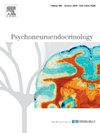一项为期两年的前瞻性研究:探讨具有脆弱人格特质的肢体损伤患者血清BDNF水平降低与延迟性PTSD之间的关系
IF 3.6
2区 医学
Q2 ENDOCRINOLOGY & METABOLISM
引用次数: 0
摘要
这项纵向研究调查了血清脑源性神经营养因子(sBDNF)水平、人格类型和创伤后应激障碍(PTSD)发展之间的关系,区分了两年内身体损伤个体的早发性和晚发性PTSD。从创伤中心招募了895名中度至重度受伤的成年人,并在受伤后一个月内进行了评估。基线评估包括sBDNF测量和使用大五人格量表-10的人格评估,该量表将参与者分为弹性人格类型和脆弱人格类型。还收集了全面的社会人口统计学和临床数据。分别在伤后3、6、12、24个月使用DSM-5临床创伤后应激障碍量表进行PTSD诊断,并通过logistic回归分析探讨sBDNF水平、人格类型和PTSD发病之间的相互作用。在总样本中,107人(11.9 %)为早发性PTSD - 76人(8.4 %),31人(3.5 %)为晚发性PTSD。较低的sBDNF水平显著预测易受伤害人格类型的延迟性PTSD (N = 15)。这一发现在具有弹性人格特征的个体(N = 16)或早发性创伤后应激障碍(N = 76)中没有发现。研究结果表明,神经生物学脆弱性(sBDNF水平)和心理倾向(易受伤害的人格类型)在创伤后应激障碍的发生过程中存在复杂的相互作用,可能加深对创伤后应激障碍病因学的理解。本文章由计算机程序翻译,如有差异,请以英文原文为准。
Exploring the association between lower serum BDNF levels and delayed-onset PTSD in physically injured patients with vulnerable personality traits: A two-year prospective study
This longitudinal study investigated the relationships among serum brain-derived neurotrophic factor (sBDNF) levels, personality types, and the development of posttraumatic stress disorder (PTSD), distinguishing between earlier- and delayed-onset PTSD over two years in individuals with physical injuries. A total of 895 adults with moderate to severe injuries were recruited from a trauma center and assessed within one month post-injury. Baseline evaluations included sBDNF measurements and personality assessments using the Big Five Inventory-10, which classified participants as having either resilient or vulnerable personality types. Comprehensive socio-demographic and clinical data were also gathered. PTSD diagnoses were made at 3, 6, 12, and 24 months post-injury using the Clinician-Administered PTSD Scale for DSM-5, with logistic regression analyses exploring the interactions among sBDNF levels, personality types, and PTSD onset. Of the total sample, 107 individuals (11.9 %) developed PTSD—76 (8.4 %) with earlier-onset and 31 (3.5 %) with delayed-onset PTSD. Lower sBDNF levels significantly predicted delayed-onset PTSD in those with a vulnerable personality type (N = 15). This finding was not detected in individuals with resilient personality traits (N = 16) or those with earlier-onset PTSD (N = 76). The findings suggest the intricate interplay between neurobiological vulnerabilities (sBDNF levels) and psychological predispositions (vulnerable personality types) in the genesis of PTSD, potentially deepening the understanding of PTSD etiology.
求助全文
通过发布文献求助,成功后即可免费获取论文全文。
去求助
来源期刊

Psychoneuroendocrinology
医学-精神病学
CiteScore
7.40
自引率
8.10%
发文量
268
审稿时长
66 days
期刊介绍:
Psychoneuroendocrinology publishes papers dealing with the interrelated disciplines of psychology, neurobiology, endocrinology, immunology, neurology, and psychiatry, with an emphasis on multidisciplinary studies aiming at integrating these disciplines in terms of either basic research or clinical implications. One of the main goals is to understand how a variety of psychobiological factors interact in the expression of the stress response as it relates to the development and/or maintenance of neuropsychiatric illnesses.
 求助内容:
求助内容: 应助结果提醒方式:
应助结果提醒方式:


